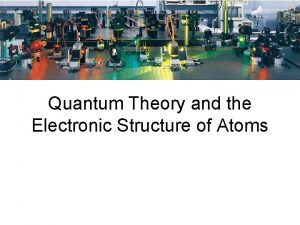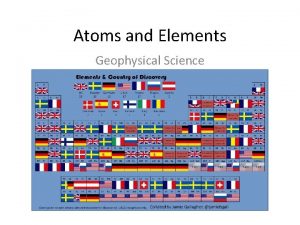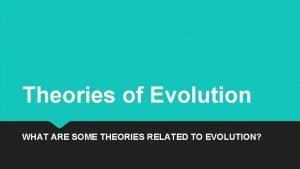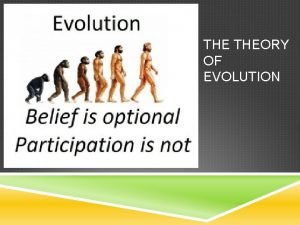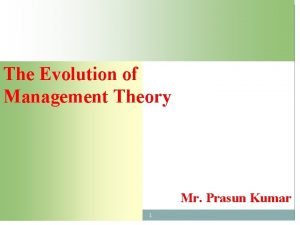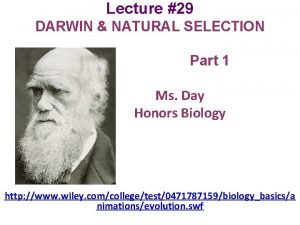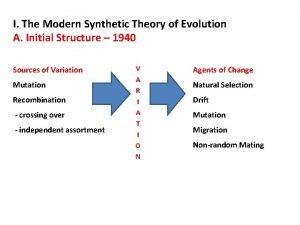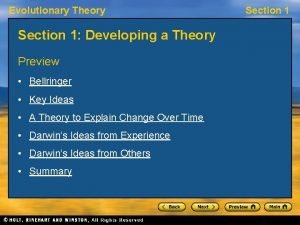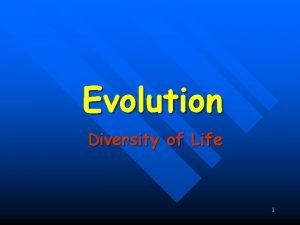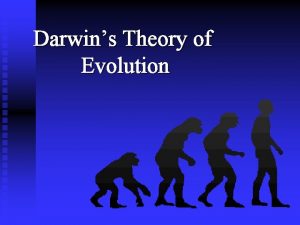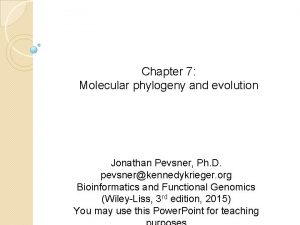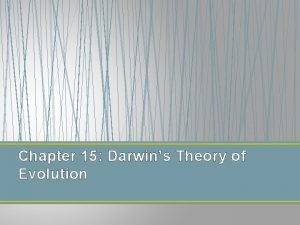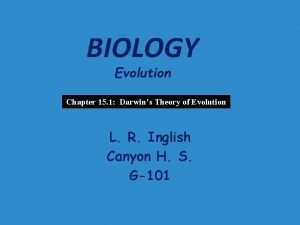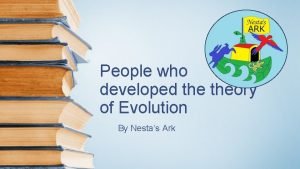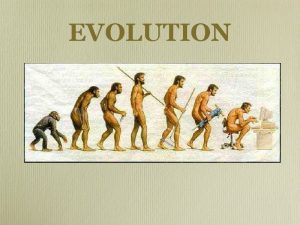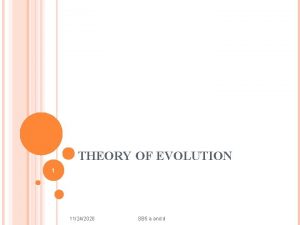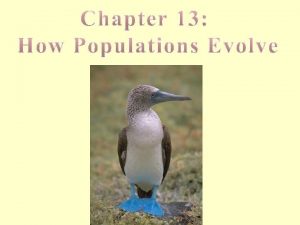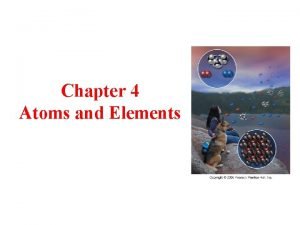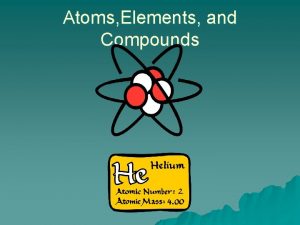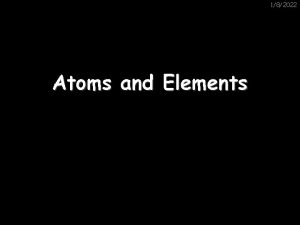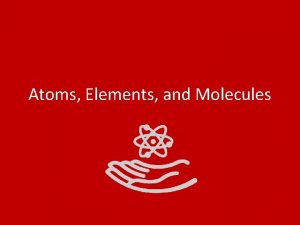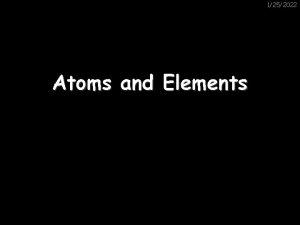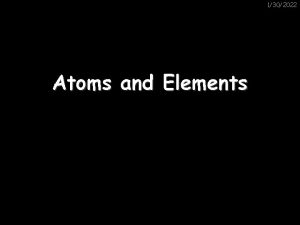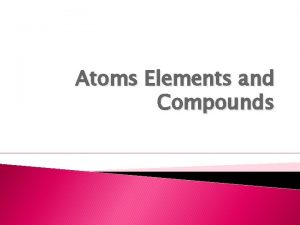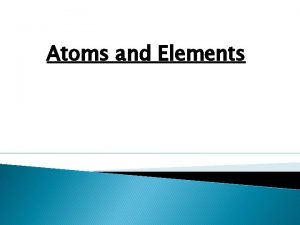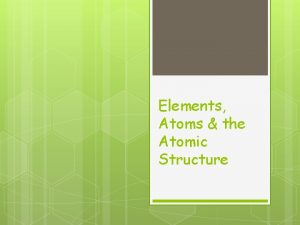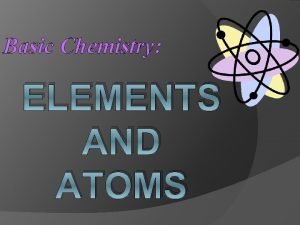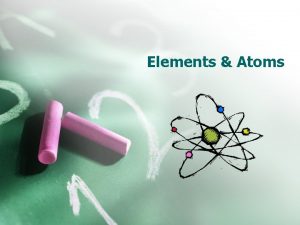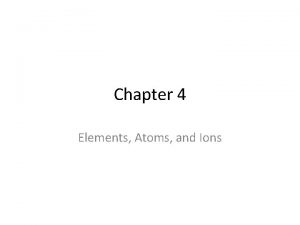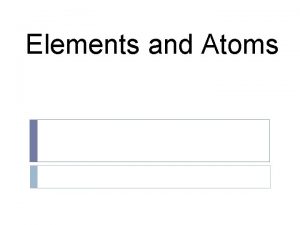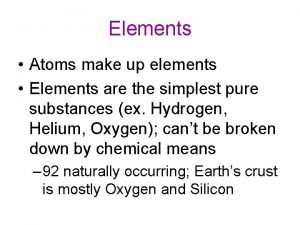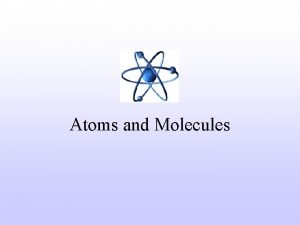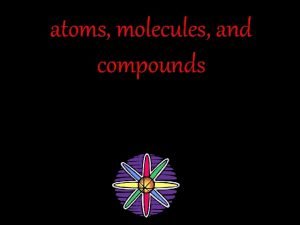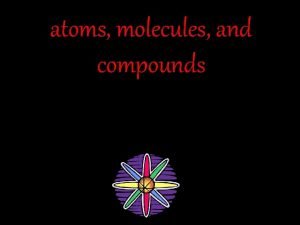ELEMENTS AND ATOMS Evolution of the Element Theory































- Slides: 31

ELEMENTS AND ATOMS

• Evolution of the Element Theory – Monists – Four Elements and Alchemy – Phlogiston and the Study of Airs – Lavoisier and Chemistry • Discovery of Elements – Electrolysis – Spectroscopy – Periodic Laws • The Electron • Discovery of the Nucleus • Models of the Atom

The Presocratic Monists All material is made of one elementary substance: – Thales of Miletus (624 -546 BCE): all is water – Anaximander of Miletus (610 -546 BCE): all is apeiron – Anaximenes of Miletus (585 -528 BCE): all is air – Heraclitus of Ephesus (535 -475 BCE): all is fire (=change) – Pythagoras of Samos and Croton (570 -495 BCE): all is number – Democritus of Abdera (460 -370 BCE): all is atom

FOUR ELEMENT THEORIES • Attributed to Empedocles of Agrigentum (490 -430 BCE) and formalized by Aristotle of Stagira (384 -322 BCE). • According to Aristotle in his On Generation and Corruption: – Air is primarily wet and secondarily hot. – Fire is primarily hot and secondarily dry. – Earth is primarily dry and secondarily cold. – Water is primarily cold and secondarily wet.

FOUR HUMOR THEORY Humor (χυμός, chymos = sap or juice) Formalized by Hippocrates of Kos (460 -370 BCE) who tied a mechanistic theory of disease to the 4 elements and the weather.

INFLUENCE OF ALCHEMY • Egyptian material religion [Khemeia (χημεία), meaning black (for the hidden arts) or black earth (an ancient reference to Egypt)]. With arabic prefix al-, it becomes al-khemeia or alchemy. • Purpose to improve material • Used careful methods and precise measurements • Introduced to Greek Natural Philosophy • Continued and augmented by alchemists in the Islamic Empire

Paracelsus and Iatrochemistry • Took name Paracelsus, which means beyond Celsus, author of a 1 st century medical encyclopedia • Rejection of Hippocrates’ theory of health and Galen’s anatomy • Merger of alchemy and medicine • Three principles: sulfur, mercury, salt • The poison is the cure Philippus Aureolus Theophrastus Bombastus von Hohenheim 1493 -1541; Switzerland Austria

German Iatrochemical School • Johann Joachim Becher, devised theory of combustion based on phlogiston [from Greek φλογιστόν- phlogistón (burning up)] • Georg Ernst Stahl, provided experimental support for phlogiston Becher, 1635 -1682, Present-day Germany and England Stahl, 1659 -1734, Present-day Germany

Chemistry of Phlogiston

1728 -1799 The Study of Airs • Joseph Black: fixed air (carbon dioxide) • Henry Cavendish: inflammable air (hydrogen) • Joseph Priestley: dephlogisticated air (oxygen) 1731 -1810 1733 -1804

Priestley, son of the Enlightenment • Dissenting clergyman • Theologian and founder of Unitarianism • Educator (English Grammar & Chart of History) • Political theorist • Inventor (soda water; erasers) • Natural Philosopher – electricity – gasses

Antoine-Laurent de Lavosier • Minor nobility of France • Degree in law but never practiced • Early work on Geology, chemistry of minerals, and meteorology • Began the study of combustion and noted that sulfur and phosphorus increased in weight after burning • Thus, phlogiston would have to have negative weight • Met Priestley (1774) • Began work on oxygen (1775) and rejected phlogiston theory Marie-Anne (1758 -1836) and Antoine (1743 -1794)

Elements of Chemistry • Published in 1789 • Contained 55 substances that could not be decomposed into simpler substances (elements) • Statement of conservation of mass • First modern text that defined the science of chemistry

• Lavoisier had offended Marat and had been a member of a tax collecting commission • Judgment of the court: The Republic needs neither scientists nor chemists; the course of justice cannot be delayed. • Despite important work on the Gunpowder Commission and his support for the revolution, he was beheaded in May 1794 at age 50.

Humphry Davy • Lavoisier's theory of elements quickly took over • Davy used Volta’s pile to decompose substances by electrolysis and discovered magnesium, boron, and barium • Chemistry of chlorine and iodine • Mentor to Michael Faraday 1778 -1829

Electrolysis of sodium chloride

John Dalton • Interpreted the gas laws to mean that elements must exist as atoms • Reactions are interactions of atoms • Atoms combine in whole number ratios (Laws of simple and multiple proportions) • Atoms cannot change (Law of constant composition) • Atoms have a constant weight; so the total mass of reactants must equal the total mass of product (Law of equivalent weights) 1766 -1844

• System of Dalton • Worked to define atomic weights based on Hydrogen = 1

Jöns Jacob Berzelius • Defined modern notation • Set weight of Oxygen = 100 and other elements relative to that • Confirmed law of simple and multiple proportions and supported Dalton’s atomic theory 1779 -1848, Sweden

Problem with Hydrogen Solved • Amadeo Avagadro (17761856, Italy) proposed equal volumes of all gasses at the same temperature and pressure contain the same number of molecules • Only possible if diatomics exist • Berzelius adamant: no diatomics possible • Diatomics supported by Stanislao Cannizzaro (18261910, Italy) H + Cl = HCl Unless hydrogen and chlorine exist as diatomics, this reaction should produce only one volume of HCl.

Spectroscopy • Robert Wilhelm Bunsen and Gustav Robert Kirchhoff (Germany) • Spectroscope (1859) • Used spectral signatures to search for new elements Kirchhoff (1824 -1887); Bunsen (1811 -1899)

Discovery of Helium • August 18, 1868; unusual spectral line detected in solar chromosphere during a solar eclipse

Periodic Laws • The elements seemed to have repeating or periodic properties according to molecular weights • Thus, elements appeared to occur in families like the halogens: Fluorine, Chlorine, Bromine, Iodine, all of which have similar combining properties

Development of Periodic Laws Independently defined and formalized into tabular form by Dimitri Ivanovich Mendeleev (1869) and Julius Lothar Meyer (1870) Meyer, 1830 -1895, Germany Mendeleev, 1834 -1907, Russian Empire

Discovery of the electron Sir Joseph John (J. J. ) Thomson (1856 -1940)

Discovery of the Nucleus Ernest Rutherford, 1 st Baron Rutherford of Nelson (1871 -1937; New Zealand, Canada, and Britain)

The Bohr Atom Niels Henrik David Bohr (1885 -1962; Denmark)

Electron Shells

Glen Seaborg Discoverer of plutonium and 9 other transuranium elements Removed the rare earths to make the table more compact Advisor to presidents from Truman to Clinton Former head of the AEC 1912 -1999, USA


 At stp which substance is the best conductor of electricity
At stp which substance is the best conductor of electricity Solution
Solution Section 1 atoms elements and compounds
Section 1 atoms elements and compounds Chapter 6 section 1 atoms elements and compounds answer key
Chapter 6 section 1 atoms elements and compounds answer key Chapter 6 section 1 atoms elements and compounds
Chapter 6 section 1 atoms elements and compounds What is the relationship between atoms and elements
What is the relationship between atoms and elements Signal element vs data element
Signal element vs data element Lowest allowable energy state of an atom
Lowest allowable energy state of an atom Electrons in atoms section 2 quantum theory and the atom
Electrons in atoms section 2 quantum theory and the atom Quantum theory and the electronic structure of atoms
Quantum theory and the electronic structure of atoms Carbon 12 symbol
Carbon 12 symbol Www.chem.purdue/gchelp/atoms/elements.html
Www.chem.purdue/gchelp/atoms/elements.html Signal element vs data element
Signal element vs data element Lamarck's theory of evolution
Lamarck's theory of evolution Developmental homology
Developmental homology Evolution of management theory
Evolution of management theory What was lamarck's theory of evolution
What was lamarck's theory of evolution Modern synthetic theory of evolution notes
Modern synthetic theory of evolution notes Modern evolution theory
Modern evolution theory Lamarck’s theory of evolution.
Lamarck’s theory of evolution. What was lamarck's theory of evolution
What was lamarck's theory of evolution Chapter 15 darwin's theory of evolution
Chapter 15 darwin's theory of evolution Neutral theory of molecular evolution notes
Neutral theory of molecular evolution notes Chapter 17 darwin's theory of evolution
Chapter 17 darwin's theory of evolution Chapter 15 section 3: shaping evolutionary theory
Chapter 15 section 3: shaping evolutionary theory Chapter 15 darwin's theory of evolution section 15-1
Chapter 15 darwin's theory of evolution section 15-1 Chapter 15 darwin's theory of evolution section review 15-1
Chapter 15 darwin's theory of evolution section review 15-1 Charles darwin theory of evolution
Charles darwin theory of evolution Who formulated theory of evolution? *
Who formulated theory of evolution? * Lamarck theory of evolution notes
Lamarck theory of evolution notes Theory of evolution
Theory of evolution Theory of evolution
Theory of evolution









